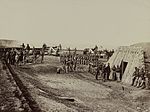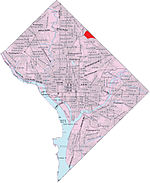1906 Washington, D.C., train wreck
1906 in Washington, D.C.Accidents and incidents involving Baltimore and Ohio RailroadDecember 1906 eventsNortheast (Washington, D.C.)Rail accidents caused by a driver's error ... and 6 more
Railway accidents and incidents in Washington, D.C.Railway accidents in 1906Railway accidents involving a signal passed at dangerRailway accidents involving fogTrain collisions in the United StatesUse mdy dates from May 2020
The 1906 Washington, D.C., train wreck occurred on the Metropolitan Branch of the Baltimore and Ohio Railroad (B&O) at Terra Cotta station in Washington, D.C., on December 30, 1906, at 6:31 in the evening, when a locomotive pulling six empty cars crashed into the back of a passenger train in dense fog, killing 53 people and injuring more than 70.
Excerpt from the Wikipedia article 1906 Washington, D.C., train wreck (License: CC BY-SA 3.0, Authors).1906 Washington, D.C., train wreck
Galloway Street Northeast, Washington Fort Totten
Geographical coordinates (GPS) Address Nearby Places Show on map
Geographical coordinates (GPS)
| Latitude | Longitude |
|---|---|
| N 38.951777 ° | E -77.002174 ° |
Address
Fort Totten
Galloway Street Northeast
20011 Washington, Fort Totten
District of Columbia, United States
Open on Google Maps









